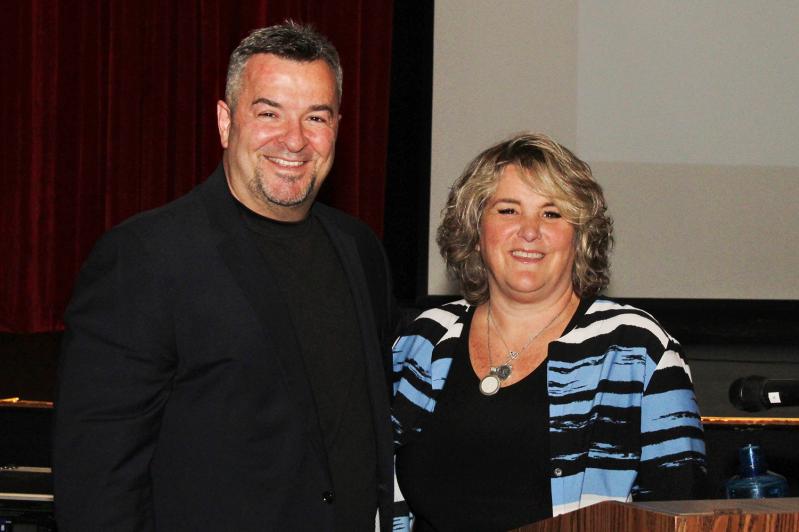Among adults younger than 65, alcohol-related deaths in 2020 actually outnumbered deaths from Covid-19, according to a study published in March that was conducted by researchers with the National Institute on Alcohol Abuse and Alcoholism, a division of the National Institutes of Health.
Recognizing that a pandemic, remote learning, stay-at-home rules, and an overreliance on technology has taken a toll on schoolchildren, East Hampton High School held its fifth annual forum on addiction last week. Titled “Protecting Our Children From Screen Addiction and Substance Abuse,” it was attended on April 27 by parents, community members, and a handful of students.
About 10 organizations that specialize in substance abuse recovery programs, such as Phoenix House, and nonprofit groups like OLA and the Retreat that work with teens, as well as local police officers, had tables set up in the high school lobby offering literature on their various services. Perhaps the most startling display was on the police table: a glass case containing various drug paraphernalia that had been found on East Hampton students. Included were packets of marijuana edibles that were designed to look almost identical to well-known candy brands.
“Yeah, they look just like Sour Patch Kids,” said Devin Toia, an East Hampton police officer. “But they’re not candy.”
Inside the auditorium, Sara Smith, the high school principal, spoke about the need to “commend our students,” pointing to the fact that these young adults have had to navigate through a time like no other. She then introduced the evening’s first guest speaker, Kym Laube, the executive director of Human Understanding and Growth Services Inc. (a program known locally as HUGS).
Ms. Laube, a nimble public speaker, had one clear message to impart: “Don’t make it easy for your kids to use,” she repeated constantly. A recovering alcoholic, she advised parents to disallow kids to drink until their brains are fully developed: for boys, age 25; 21 for girls. As the head of an advocacy nonprofit, mother of two boys, and wife of a police officer, she said, “We were the biggest buzzkill parents any kids could have.”
Using interactive exercises, Ms. Laube demonstrated that we are wired to mimic what we see rather than to listen to what is being told to us. “It’s not about what we say. It’s about what we do,” she reiterated about the responsibility parents have to practice healthy habits at home regarding drug and alcohol use.
Ms. Laube shared grim statistics, exacerbated by Covid, many horror stories, and her “Just say no” approach, which not all experts agree with.
David Sheff, the author of the books “Beautiful Boy,” the story of his son’s addiction, and “Clean,” about treating and preventing drug addiction, recently wrote in The New York Times, “The research shows that for a conversation to make a difference, it must rely not on scare tactics — dire warnings and exaggerated fears — but facts. The goal is to get kids to think.” He added that adults must understand why their children might be using drugs or alcohol in the first place. If it’s the level of stress and anxiety in their lives, then telling them to just say no isn’t enough; we have to help them manage that stress. Mr. Sheff’s advice is for parents to validate their children’s feelings, and help them develop the emotional vocabulary and coping mechanisms to navigate their lives, substance free.
The evening’s second speaker, Dr. Nicholas Kardaras, a psychologist and an expert on mental health, addiction, and the impacts of the digital age, is also the author of “Glow Kids: How Screen Addiction Is Hijacking Our Kids — and How to Break the Trance.” His presentation focused on the negative impact technology is having on the lives of children.
“This is the most challenging time for mental health,” he said at the forum, pointing out that during Covid, screen time doubled and rates of depression tripled. Suicide and overdose levels were at an all-time high, as were anxiety rates and diagnoses of attention deficit hyperactivity disorder. In his upcoming book, “Digital Madness,” the psychologist specifically addresses teens and young adults by examining the mental health impact of tech addiction and corrosive social media.
Statistically, screen addiction is one of the most pervasive issues today, affecting children as young as 3. Among teenagers, a study by Common Sense Media in 2016 found that 50 percent of teens in the U.S. believe that they are addicted to smartphones, a number which is undoubtedly higher now because of Covid.
Parents were called upon once more to serve as role models for their children. Reviewing one’s own screen time, managing time spent on electronic devices, especially for very young children, and prioritizing daily (non-screen) routines over screen use, are some of the ways adults can help children around them.
One particularly disturbing example Dr. Kardaras shared was “TikTok Tourette.” In a Wall Street Journal article last year, it was reported that an influx of teens started turning up in doctors’ offices with sudden, severe physical tics. Specialists discovered that the girls had been watching TikTok videos made by an influencer who suffered from Tourette syndrome. This immersion in social media is fueling a toxic “digital social contagion” by spreading a variety of psychiatric disorders, said Dr. Kardaras.
Forums such as these are thought to encourage students, parents, educators, therapists, public health professionals, and policymakers to engage in open conversations about difficult subjects. By providing children and parents with the right vocabulary to discuss addictions, communities everywhere will have the tools to seek help, when needed.
The forum will be available shortly on LTV.

